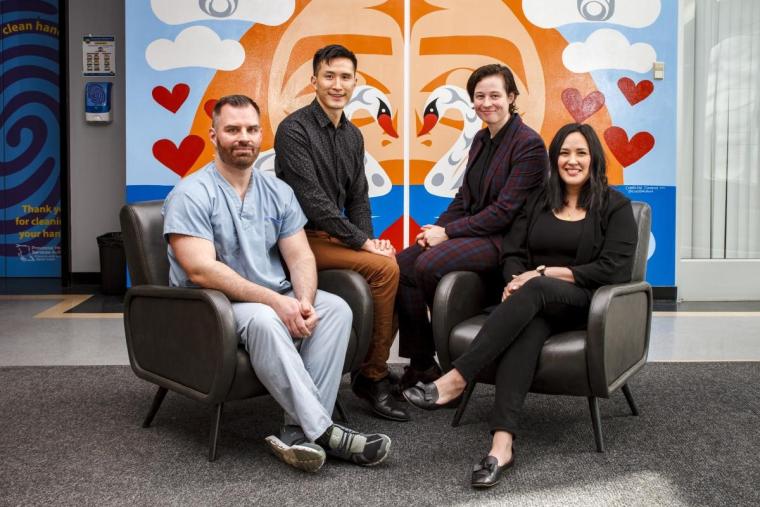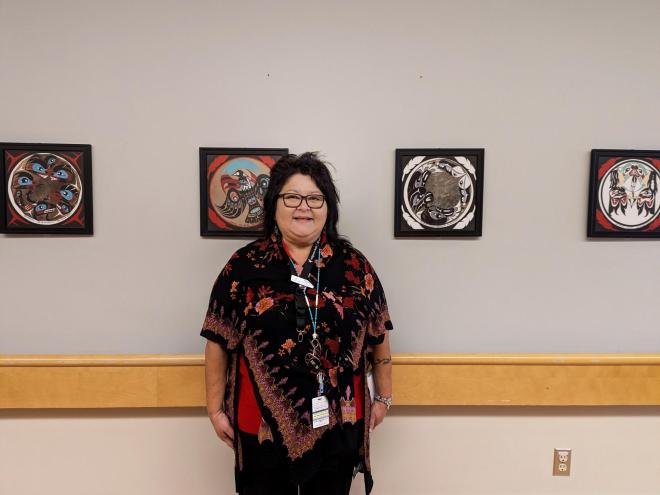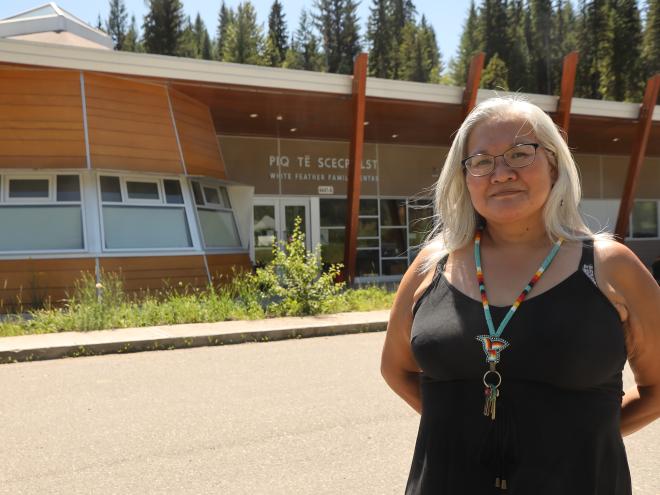
The CPS STI/HIV Services leadership team, from left to right: Dr Troy Grennan, Medical Lead, STI/HIV Services, Dr Jason Wong, Medical Director, Clinical Prevention Services, Jay McBain, Senior Practice Lead, STI/HIV Services, Karmen Olson, Public Health Manager, STI/HIV Services.
Dr Jason Wong, a public health and preventive medicine physician, has long had a passion for helping patients to stay healthy by reducing the transmission of HIV and sexually transmitted infections (STIs).
Chlamydia, gonorrhea, and syphilis, which are the three reportable bacterial STIs have increased dramatically in BC over the past decade. Dr Wong notes that untreated, STIs can lead to complications, including pelvic inflammatory disease, ectopic pregnancy, and epididymo-orchitis. STIs can also be transmitted during pregnancy or delivery which can have negative consequences on newborns. Partner notification, the process in which sexual partners are alerted that they have been exposed to an STI and offered counselling, screening, and treatment, is an important intervention to prevent the spread of STIs.
With funding and support from the Joint Collaborative Committees (JCCs), the team set out to make a difference for patients and for our communities.
A senior medical leader at BC Centre for Disease Control (BCCDC), Dr Wong led the BCCDC’s FY2020/21 Health System Redesign (HSR) project and was the executive sponsor for the FY2021/22/23 HSR Project.
Gathering information as the first step
Dr Wong and his team got the support they needed from the JCCs’ Health System Redesign (HSR) project. They understood that collaboration would be critical to success.
“Public health as a speciality often feels fairly removed from the health care system for a couple of reasons. One is we don’t see patients like your family doctor. Our patients are really the population. The way that we work is really with partnerships, collaboration, long-term relationship building, and working through policies and processes to try and move the needle around population health,” said Dr Wong.
The project unfolded in two phases. In the first part of the project, a survey was sent out to BC family doctors to assess their awareness of partner notification and how they used it for patients with HIV/STIs. The goal was to understand how family doctors, who diagnose the majority of STIs, could be better supported in this practice. As there is generally few resources to support family physicians to perform partner notification, it also examined what tools could be developed to support partner notification.
They found there was the need for more resources that could help partner notification, as well as further clarify the roles and responsibilities around partner notification.
Comparing public health approaches
The second part of the project explored different public health approaches to partner notification. The team also interviewed practitioners from across BC, including nurses and physicians, to learn about their practices of partner notification and their thoughts on different approaches.
These HSR projects, coupled with other work in this area, supported a policy decision to change the provincial approach to chlamydia/gonorrhea partner notification, the most commonly diagnosed STIs in BC. This includes developing future resources to better support patients through their STI care journey.
On the experience working with the JCCs, Dr Wong says, “People are really generous. We work in an environment where people are very generous with their time, expertise, and experience. This is a great opportunity to collate that, build on it and share it more widely.”
The HSR funding was used to compensate physicians for their participation in short-term, project-based, system redesign work within a health authority or community with health authority involvement. Funding is provided through the Joint Collaborative Committees (JCC) of Doctors of BC and the Ministry of Health. The JCCs are made up of the Specialist Services Committee (SSC), Shared Care Committee (SCC), and Family Practice Services Committees (FPSC).
Making connections through Facility Engagement
In addition to his work on HSR projects, Dr Wong is also involved in Facility Engagement (FE) initiatives, as well as the Doctors of BC’s Section of Public Health and Preventive Medicine specialists.
Dr Wong also saw many benefits of participating in FE initiatives. He said FE funding provided new opportunities to work with his colleagues and to work on projects that his team felt were priorities. Another benefit of this work for Dr Wong was getting to meet and work with other PHSA MSAs.
As Dr Wong explains, “Even though our practices are very different, it was very helpful to even hear that some of our issues are kind of the same. They are obviously different in many ways but there are some commonalities and threads within them. It facilitated those connections.”
FE was launched by the SSC as a BC-wide initiative to strengthen communication, relationships, and collaboration between facility-based physicians and their health authorities.
Advice to physicians considering applying for SSC funding
When asked what his advice would be to other physicians considering doing projects through SSC funding, he replied that applying is not that onerous on physicians and encourages other physicians to consider it.
Dr Wong’s success in helping to maintain and enhance the health of British Columbians is just one example of the way the JCCs are making a real impact for patients, their families, and our communities.
Dr Wong’s team’s work related to the HSR project has been published in the several peer-reviewed journals. To read the findings, visit:



